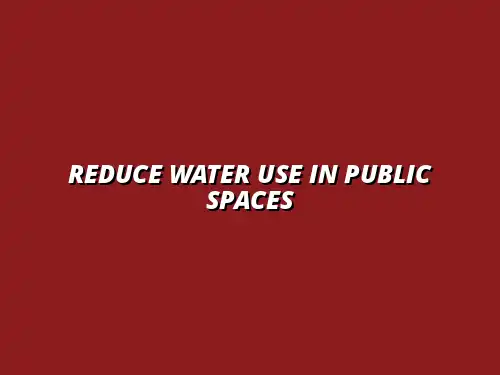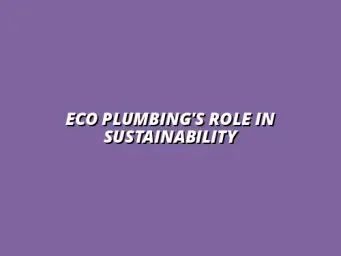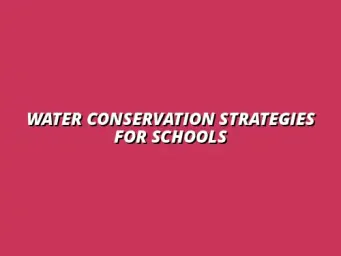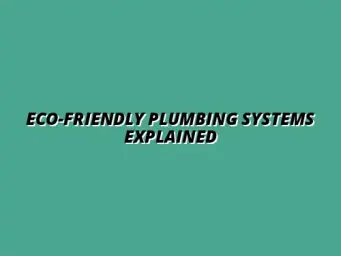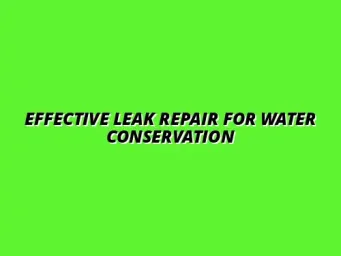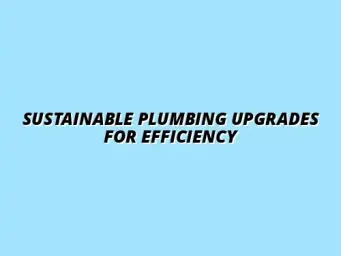Understanding the Importance of Water Conservation in Public Spaces
Water conservation is crucial, especially in public spaces where large amounts of water are used daily. Parks, plazas, and recreational areas contribute significantly to overall water consumption. It's important to understand how these spaces use water and what impact their usage has on the environment and our communities. Implementing water-saving tips for your home can also have a positive impact on overall water usage.
Public spaces often feature extensive lawns, flower beds, and water features, all of which require watering. By recognizing the importance of water conservation in these areas, we can take steps to reduce waste and create a more sustainable future.
The Role of Public Spaces in Water Usage
Public spaces like parks and recreational areas account for a notable portion of water usage in urban settings. These areas need water for various activities, including maintaining green spaces, providing water for children to play, and keeping facilities operational. Each of these factors contributes to the overall demand for water. Regular water pressure checks can help identify leaks and prevent unnecessary water waste in public spaces too.
- Parks: Require irrigation for lawns, trees, and flower beds.
- Recreational areas: Need water for washing facilities and play areas.
- Plazas: Sometimes include fountains that use significant water resources.
By understanding the extent of water consumption in public spaces, we can find effective ways to implement conservation strategies. This knowledge can guide us to make informed decisions that balance the need for green spaces with the necessity of responsible water usage.
Environmental and Economic Impacts of Water Waste
Excessive water usage in public areas can lead to severe environmental issues. For instance, over-irrigation can contribute to soil erosion, run-off pollution, and depletion of local water sources. These problems can harm wildlife and reduce the health of ecosystems. Learning about urban water conservation is key to understanding these impacts further.
Moreover, the economic implications of water waste are significant for municipalities. Cities may face higher costs associated with water treatment, supply, and maintenance. Additionally, the strain on water resources can lead to increased taxes or fees for residents. Regular water heater maintenance can also contribute to cost savings and reduced water waste.
- Environmental Issues:
- Soil erosion and run-off pollution
- Threats to local wildlife and ecosystems
- Economic Implications:
- Higher costs for water supply and treatment
- Increased taxes or fees for residents
Addressing these challenges through water conservation measures can lead to both environmental and economic benefits. By making a conscious effort to reduce water usage, we can create healthier communities and protect our precious resources for future generations.
Practical Strategies for Reducing Water Consumption in Public Areas
Now that we understand the importance of water conservation in public spaces, we can explore practical strategies to reduce consumption. Implementing efficient practices and technologies can make a tremendous difference. It's about being smart and proactive in how we manage our water resources. Consider installing a water-saving toilet in public restrooms as one example.
Every public space can benefit from innovative strategies tailored to its unique needs. By focusing on water-efficient landscaping, upgrading irrigation systems, and promoting water-saving fixtures, we can significantly reduce water consumption.
Addressing Common Questions about Water Conservation in Public Spaces
Water conservation in public spaces is a vital topic that raises many questions. Understanding how local governments can play a part is key to fostering sustainable practices. By addressing these questions, we can uncover how communities can work together to safeguard our water resources. Adopting sustainable water practices for businesses also extends to public spaces.
How Can Local Governments Support Water Conservation Initiatives?
Local governments have a significant role in promoting water conservation through policy-making and funding. They can enact regulations that encourage or even require water-saving measures in public spaces. Additionally, governments should allocate funding for programs aimed at upgrading infrastructure and enhancing public awareness.
- Enact Regulations: Create laws that mandate water-efficient practices in public facilities.
- Provide Funding: Allocate budgets for water conservation projects and educational initiatives.
- Support Research: Invest in studies that explore innovative methods for reducing water usage.
- Collaborate with NGOs: Partner with non-profit organizations to implement community outreach programs.
Through these actions, local governments can drive significant changes that benefit both the environment and the community. It’s important for them to lead by example and show that conserving water is a shared responsibility.
What Are the Benefits of Reducing Water Usage in Parks and Recreation Areas?
Reducing water usage in parks and recreational areas offers numerous benefits. These advantages not only support environmental health but also enhance the overall quality of life for community members. Here are some key benefits:
- Cost Savings: Lower water bills can free up funds for other community projects.
- Improved Environmental Conditions: Less water usage leads to healthier ecosystems and less strain on local water supplies.
- Enhanced Community Engagement: When communities come together for conservation efforts, it strengthens social ties.
- Increased Aesthetic Value: Well-maintained, sustainably designed parks enrich the beauty of our neighborhoods.
These benefits illustrate why it’s crucial for communities to focus on sustainable water practices in public areas. By doing so, we create healthier environments and promote a sense of pride among residents. Remember simple water-saving tips for your home can be easily adapted for public spaces.
Future Directions for Sustainable Water Use in Public Areas
Looking ahead, the future of sustainable water use in public spaces depends heavily on community involvement and proactive planning. Engaging individuals and organizations in conservation efforts will play a crucial role in shaping effective strategies moving forward.
Integrating Community Involvement in Water Conservation Efforts
Community involvement is essential for cultivating a culture of conservation. When people feel engaged in efforts that affect their environment, they are more likely to make lasting changes. Here are some ways to encourage local participation:
- Volunteer Programs: Organize clean-up events or tree-planting days that focus on water conservation.
- Educational Workshops: Provide workshops on water-saving techniques and the importance of conservation.
- Awareness Campaigns: Use social media and local events to spread the word about water conservation efforts.
By inviting community members to participate in these initiatives, we build a sense of ownership and responsibility towards our shared water resources. Everyone can contribute to making a difference!
Setting Long-Term Goals for Water Efficiency in Urban Planning
Incorporating water conservation into urban planning is crucial for sustainable development. As cities grow, they must prioritize water efficiency as a core principle. Here are some strategies for setting long-term goals:
- Incorporate Green Infrastructure: Design parks and public spaces to capture and utilize rainwater effectively.
- Promote Sustainable Building Practices: Encourage the use of water-efficient materials and designs in public buildings.
- Monitor and Adjust: Regularly assess water usage and make necessary adjustments to strategies and goals.
By planning for water efficiency, we set the stage for healthier cities that can sustain future generations. It's vital to think ahead and implement these goals now for a better tomorrow.
Final Thoughts on Optimizing Water Usage in Public Spaces
As we reflect on the significance of water conservation in public spaces, it's clear that every action counts. From local governments supporting initiatives to community members engaging in conservation efforts, we all have a role to play. I encourage you to consider how you can implement these practices in your community—together, we can make a meaningful impact!

